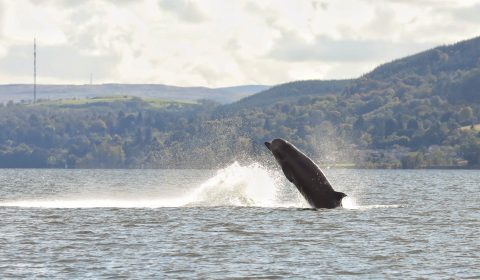Following extensive planning and coordination with other agencies over the preceding week, a briefing was held in Centre 81, Garelochhead at 9am for those involved in the planned relocation. This was streamed over a closed WhatsApp group for the benefit of those in other locations along the planned route.Attending were BDMLR medics, Coastguard, RB Marine, RNLI and the Sea Shepherd Conservation Society.
The initial plan was to use a small group of boats to surround the animals in a U-shaped formation and repel them using engine noise southwards to the mouth of the Loch and out to the Firth of Clyde. From there, a second set of boats would be blocking the Clyde and the two groups together would then try to pivot the pod of whales and proceed west along the Clyde. The mouths of the Holyloch, Loch Long and the eastern channel around Cumbrae would be similarly blocked and land-based medics and coastguard teams were standing by to aid the efforts.
Alternate strategies including the potential use of ‘banging poles’ were also outlined to the group.On forming up, two adult northern bottlenose whales were spotted and the boats moved into position and began to drive forward, however the animals soon evaded the line and surfaced behind the boats. The group reset the position upwater of the whales, repeating this pattern of events several times, slowly moving the animals south and improving cohesion of the line as well as being joined by a RIB from Marine Scotland out of Largs.
Just after midday, the group were able to keep the animals moving forward and herded them to the mouth of the Rhu Narrows where they were lost in the deeper water; this pair were not identified again in the Loch while boats were in the water so are suspected to have left through the narrows at that point.After waiting in position for further sightings, the land-based watchers identified 3 animals in the water just south of Garelochead. When the boats arrived at the location, it was apparent that there was a parent/juvenile pair and a single large adult. This proved difficult to manage as what were essentially 2 groups kept far enough apart that they couldn’t be driven together. The team concentrated on the pair, attempting to drive them south however they proved very elusive and so the team concentrated on the single whale when the pair evaded and stayed submerged.
Around 3pm, having had numerous attempts to drive the animals, the decision was made to resort to using banging poles.
By this point, we had moved all boats from outside the loch inside to attempt to put as much noise as possible into the water to drive the animals south. Several more short attempts were made and evaded, however the whales were driven south to Roseneath before evading and on subsequent attempts were herded to the Rhu Narrows again.After waiting there for further news, the MOD reported a sighting in the area of the peace camp south of the naval base.
The boats returned to the sighting area around 4.40pm and due to the risk of failing light, prepared for a final attempt but the animals did not resurface and land based watchers were unable to spot anything either and after spending time searching, the boats and land crews were stood down at around 5.40pm.During debrief, a decision was made not to return for a second day due to uncertainty whether we could bring the same number of boats and crews back to the scene; concern over stress levels in the animal and that simply repeating the same manouvers would not be any more likely to succeed given the geography and behavior of the whales.
Given there are no previous international records of northern bottlenose whales being herded and the overall gaps in knowledge about the species, combined with the geography of Gareloch this was always going to be a difficult attempt with success not guaranteed. We have however leant a great deal about the behavior of these whales for any future relocation of the species and given the short window for organising and conducting the relocation attempt, we are hugely proud of the efforts of the BDMLR team and likewise grateful to the many organisations who assisted this endeavor.
Our medics and teams will continue to monitor both the area and the whales behaviours and movements and will reassess the situation is required.
We would like to thank the following:
BDMLR Land and Boat based Crews and RIB Naomi.
RB and Swordfish Marine – Provided 6 Boats and crew as well as more planned had we left the loch
Dean Durrant, RNLI provided private boat- Marine Scotland – provided RIB and Crew out of Largs
Greenock Police Dive Unit – Provided boat ‘Guardian’ and crew- Sea Shepherd Conservation Society – Provided RIB Phantom and Crew out of Inverkip
HMCG who provided overwatch and land crews at the Loch and had crews standing by along the length of the Clyde for spotters
MOD – Helped to coordinate and gain approval for the attempt, MOD Police helped to gather sightings and closed the area to small boats and QHM kept larger naval vessels out of the way of rescue activity
BDMLR medic Charlie Coull, whose RIB was standing by in the Clyde should we have got the animals out.
